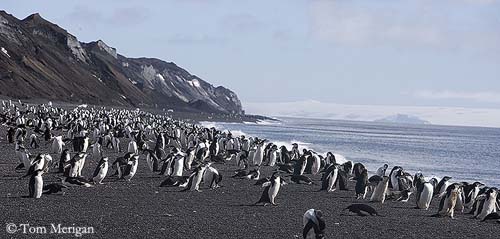
Chinstrap Penguin
Pygoscelis Antarctica
Sphenisciforme Order – Spheniscidae Family
BIOMETRICS:
Length: 68-77 cm; Weight: 3, 4-4, 9 kg.
LONGEVITY: 20 years
DESCRIPTION:
Chinstrap Penguin’s name comes from the narrow black line across its chin, as a chin-strap.
Adult has black upperparts and tail. Flippers are black, with white trailing edge.
Underparts are white, with black axillaries. Under flippers are whitish with black tip.
On the head, crown and nape are black. Face is white, extending behind the eyes. Chin and throat are white. Chin is crossed by a narrow black line joining ear-coverts of each side.
Short bill is black. Eyes are reddish-brown. Powerful legs and webbed feet are pink.
Both sexes are similar.
Juvenile shows white face, mottled black mainly around the eyes. It reaches its sexual maturity at about three years of age.
BEHAVIOUR:
Chinstrap Penguin feeds mainly on krill, small fish and crustaceans. It forages close to the shore, and catches its preys by pursuit-diving. It can dive at about 70 metres depth, but usually around 45 metres, and often at 10 metres. Dives last generally less than one minute, and it is able to swim at about 30 km per hour, thanks to its flippers.
REPRODUCTION:
Chinstrap Penguin arrives at colony in October-November. It nests in huge colonies of thousands of birds, and often with other penguins’ species.
Chinstrap Penguin breeds mainly on free-ice areas, in order to have time enough for raising their chicks. Mates form strong pair bonds, and return year after year to the same nesting site.
Nest is on the ground. It is a circular pile of stones, but very modest, with only a rim of about ten stones.
Female usually lays two eggs in November-December. Incubation lasts about 34 to 40 days, shared by both adults. They take turns with stints of one to 18 days.
At hatching, chicks are covered in pale grey down, and later, down becomes darker on upperparts and chin. When they are one month old, chicks join the crèche, and both parents can go to the sea for searching food. Both chicks are fed equally by their parents. Young fledge at about 52 to 60 days of age.
DIET:
Chinstrap Penguin feeds mainly on krill, small fish and crustaceans. It catches its preys by pursuit-diving underwater. Most of the dives last about 30 seconds.
PROTECTION / THREATS / STATUS:
Chinstrap Penguin populations are not threatened at this moment. Numbers seem to have increased, thanks to the range expansion, and also with increasing of krill populations, available with decrease of whale’s populations.
Chinstrap Penguin has some predators. Adults are attacked and killed by Leopard seals, and eggs and chicks are preyed upon by Sheathbills and Skuas.
Fr: Manchot à jugulaire
All : Kehlstreifpinguin
Esp : Pingüino Barbijo
Ital : Pigoscelide dell'Antartide
Nd : Keelband- Of Stormbandpinguïn
Russe : антарктический пингвин
Photographs by Tom Merigan
His website: Tom Merigan’s Photo Galleries
Text by Nicole Bouglouan
Sources:
HANDBOOK OF THE BIRDS OF THE WORLD vol 1 by Josep del Hoyo-Andrew Elliot-Jordi Sargatal - Lynx Edicions - ISBN: 8487334105
Wikipedia (Wikipedia, The Free Encyclopedia)
Welcome to the wonderful world of penguins (Dr. Lloyd Davis)
Les Manchots (François Durand)
Antarctic Connection (Thomas Hutchings – Gloria Hutchings)
New Zealand birds and birding (Narena Olliver)


HABITAT:
Chinstrap Penguin lives close to the sea, in rocky shores, and breed on steep slopes without snow or ice.
RANGE:
Chinstrap Penguin has circumpolar range. It is found in the Antarctic and sub-Antarctic areas. Populations are more abundant in southern Atlantic, along the coasts of South Orkneys, South Shetlands and South Sandwich Islands. Small breeding colonies occur on the Balleny Islands, south of New Zealand.



Chinstrap Penguin is partially resident in its range, but it performs dispersions. It leaves the colony and moves north, wintering in zones of pack ice from April-May to October-November.
Chinstrap Penguin uses ritual behaviours for communication. It waves head and flippers, performs bowing and gesturing, calls and preens. Territorial disputes may occur because it is very aggressive. Penguins stare at each other, point the bill upright, and sometimes charges.
During courtship displays, the male pumps the breast and holds the head upwards while it utters loud screeching calls. Other members of the colony often join it and they vocalize together. Usually, male arrives at colony long time before female. When she appears, pairing is very rapid and pair starts to copulate about 15 days before the laying.
MOVEMENTS:
Chinstrap Penguin does not fly. It can swim very well, and reaches speeds of 30 km per hour. It propels itself with help of webbed feet and flippers.


